|
REPORT ON THE SURVEY FINDINGS
1. The objectives of the MCYS survey, conducted between
December 2004 and February 2005, were to:
a) Assess the extent and pattern of gambling among
Singapore residents aged 18 years and above;
b) Assess the prevalence and profile of probable problem
and pathological gamblers (PPGs); and
c) Provide inputs for the development of preventive,
treatment and support services for pathological gamblers.
2. Screening questions were included in the survey to
identify symptoms suggestive of probable pathological gambling,
or in layman's terms, those who may be at risk of gambling
addiction. These questions were based on an internationally
established diagnostic tool (DSM-IV1) used in similar
studies in Hong Kong2 and Macau3. The
questions were further refined with professional inputs from the
staff of the Community Addictions Management Programme (CAMP) at
Institute of Mental Health (IMH) who have been treating local
problem gamblers.
3. Details on the design and methodology of the study are
provided at Appendix 1.
Participation in Gambling Activities
4. Overall, 58% of Singapore residents aged 18 and above
reported that they have participated in at least one form of
gambling activity over the last 12 months. This is lower than
the gambling participation rate reported in Hong Kong (78%) and
Macau (68%). 5. Groups with relatively higher gambling participation
included (See Table 1, Appendix 2):
- Chinese
(68%);
- Residents
aged 30 to 49 years (63%-69%);
- Residents
with post-secondary education (66%-67%); and
- Residents
with average monthly personal income of $2,000 or more
(70%-74%).
1
Diagnostic and Statistical Manual of Mental Disorders, fourth
edition (DSM-IV). See Appendix 3 for details.
2 Hong Kong's Home Affairs Bureau commissioned the Hong Kong
Polytechnic University to conduct a study of the Hong Kong people's
participation in gambling activities in 2001/2.
3 The University of Macau conducted a study on gambling
participation in Macau in 2003.
6. In terms of participation by types of gambling
activities, lotteries - 4D (53%), Toto (39%) and Singapore Sweep
(31%) - were the most popular among residents. Social gambling,
which refers to playing mahjong, card games or other games with
friends or relatives involving money, was a distant fourth
(17%). (See Table 2, Appendix 2.)
7. The median monthly betting amount on games in the last 12
months was $83. Sports betting ($200) ranked top in terms of
median monthly betting amount by game. (See Table 3 in Appendix
2.). The median monthly betting amount is higher for those with
higher personal incomes. (See Table 4 in Appendix 2.)
8. Some 63% of the respondents first gambled at 24 years old
or below. Most started with 4D (64%) or social gambling (20%).
(See Tables 5 and 6 in Appendix 2.)
Probable Problem and Pathological Gambling
9. Based on the screening criteria (at Appendix 3), 2.1% of
respondents were classified as probable pathological gamblers.
These respondents had responded positively to questions relating
to 5 or more of the screening criteria. This figure is
comparable to the rate reported in Hong Kong (1.9%) and Macau
(1.8%). Among this group, some could be more severe cases who
may require specialized help and treatment by gambling addiction
counselors (See Table 7 in Appendix 2.)
10. Specifically, higher prevalence of probable pathological
gambling was found among (See Table 8 in Appendix 2):
- Males (3.1%)
- Chinese (2.7%);
- Those aged 30 to 49 years (3.3 - 4.3%);
- Those with "A" level/polytechnic and below
education (2.3 - 3.2%); and
- Those earning $2,000 or more (4.2% - 5.9%). 11. Another 2.0% had responded positively to questions
relating to 3 or 4 of the screening criteria, and were
classified in the less severe category of probable problem
gamblers. This figure is lower than the rates reported in Hong
Kong (4.0%) and comparable to that reported in Macau (2.5%).
12. The most popular games among probable
pathological gamblers, in decreasing order of popularity are: 4D
(91%), Toto (70%) and social gambling (65%).
13. The median monthly betting amount of
probable pathological gamblers was $400. In comparison, the median
monthly betting amount among all gamblers was much lower, at $83.
(See Table 9 in Appendix 2).
14. In terms of gambling frequency, all probable
pathological gamblers reported having gambled at least once a
week in the last 12 months, whereas 30% of all gamblers gambled
less than once a week, and the remaining 70% at least once a
week. (See Table 10 in Appendix 2.)
15. Relatively higher proportions of probable pathological
gamblers started gambling regularly (at least once a week) from
18 ?29 years. (See Table 11 in Appendix 2.)
16. Further details of the above findings are provided at
Appendix 2.
APPENDIX 1
SURVEY METHODOLOGY
Questionnaire Design
1. The survey was conducted via face-to-face interviews. The
screening questions to detect probable problem and pathological
(PPG) gamblers were based on diagnostic criteria in the
Diagnostic and Statistical Manual of Mental Disorders, fourth
edition (DSM-IV) developed by the American Psychiatric
Association (APA)4. The same diagnostic criteria were
used in similar studies in Hong Kong5, Macau6
and the United States7. The screening questions
for problem and pathological gambling were further refined with
professional inputs from staff of the Community Addictions
Management Programme (CAMP) at Institute of Mental Health (IMH)
who have been treating problem and pathological gamblers.
Sampling and Data Weighting
2. A probability disproportionate stratified sampling method
was used to select the subjects. From a sampling frame of
residents' addresses, a randomly selected sample of 2,004
Singapore residents was interviewed using a structured
questionnaire between December 2004 and February 2005. The
minority ethnic groups were over-sampled to allow for meaningful
analysis. 3. The survey achieved a response rate of 90%, thus ensuring
that the results were representative. Post-survey weightings
were applied based on corresponding cohort proportions from
published resident figures by the Department of Statistics as of
June 2004.
Qualifications and mitigating factors
4. Given that the main instrument used in the study is a
survey, we can only capture "self-professed" behaviour rather than
actual behaviour. Some respondents could find the questions on
personal participation and gambling patterns sensitive. To
mitigate this, surveyors were asked to assure interviewees about
the strict confidentiality of individual responses at two
prescribed junctures of each interview. 5. A statistical test on the reliability of the tool
revealed that the screening questions were reasonably consistent
(Cronbach's alpha of 0.87).
4
A
clinical validation test had been conducted in the US as part of
the refinement process of the DSM-IV diagnostic tool on problem
and pathological gambling. Gerstein, D. R., R. A. Volberg, M. T.
Toce, H. Harwood et al. 1999. Gambling Impact and Behavior Study:
Report to the National Gambling Impact Study Commission. Chicago,
IL: National Opinion Research Center at the University of Chicago.
Toce-Gerstein, Marianna, Dean R. Gerstein & Rachel A. Volberg.
2003. "A Hierarchy of Gambling Disorders in the General
Population," Addiction 98: 1661-1672.
5 Hong Kong's Home Affairs Bureau commissioned the Hong Kong
Polytechnic University to conduct a study of Hong Kong people's
participation in gambling activities in 2001/2.
6 The University of Macau conducted a study on gambling
participation in Macau in 2003.
7 Gerstein, D. R., R. A. Volberg, M. T. Toce, H. Harwood et al.
1999. Gambling Impact and Behavior Study: Report to the National
Gambling Impact Study Commission. Chicago, IL: National Opinion
Research Center at the University of Chicago.
APPENDIX 2
DETAILED SURVEY FINDINGS
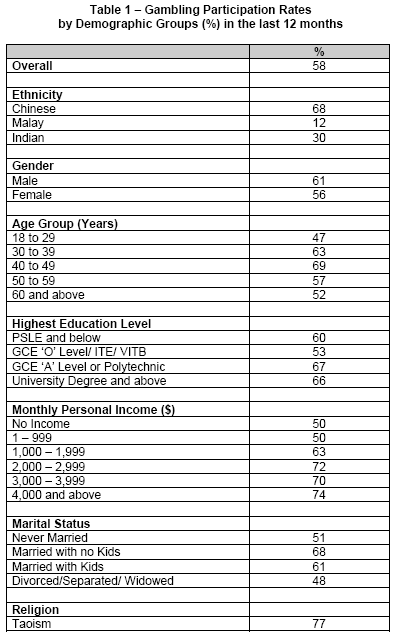
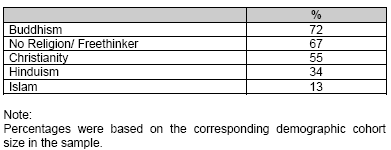
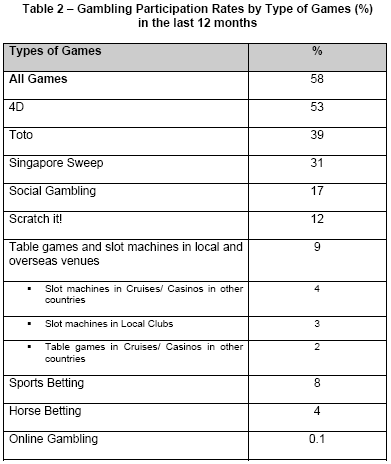
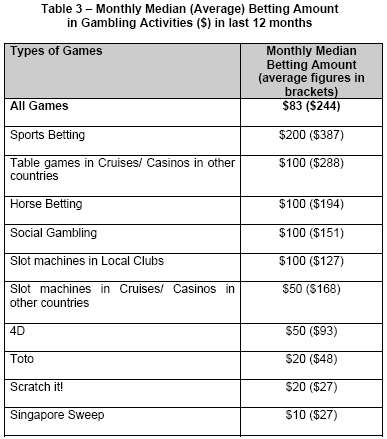
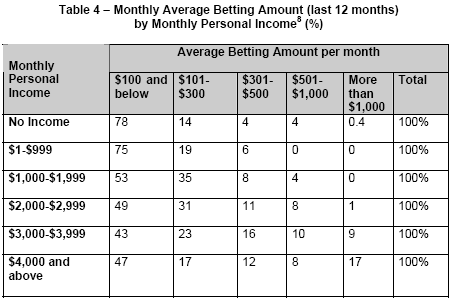
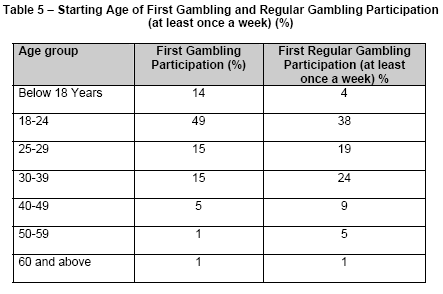

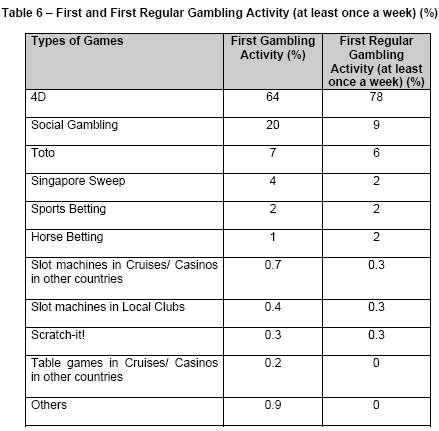
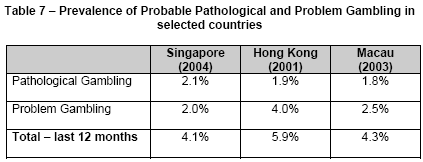
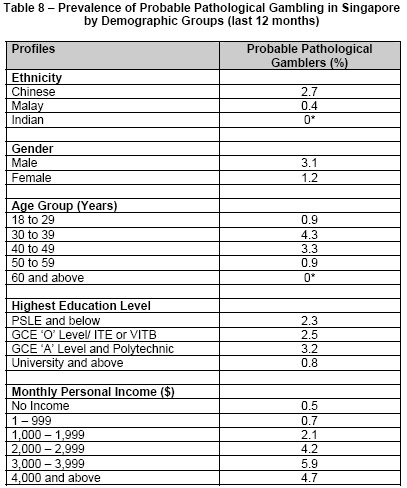
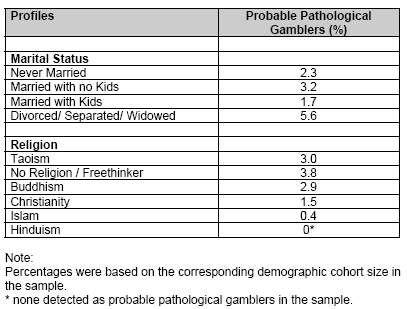
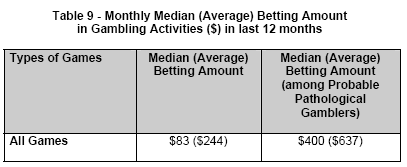
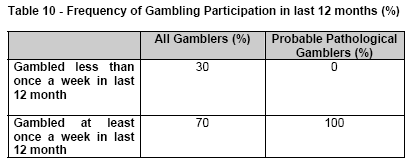
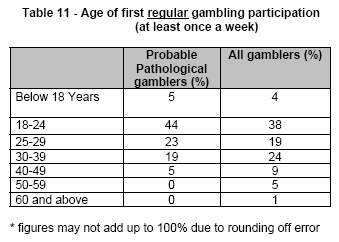
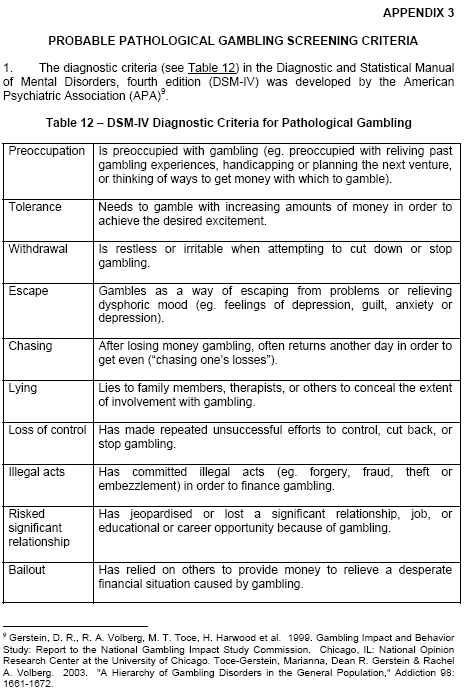
Source:
Ministry of Community
Development, Youth & Sports Press Release 13 Apr 2005
|